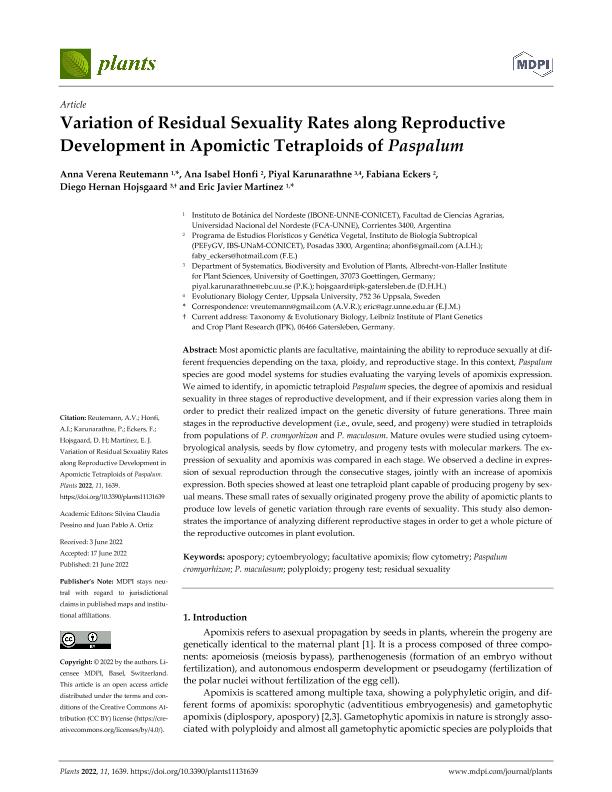Artículo
Variation of residual sexuality rates along reproductive development in apomictic tetraploids of paspalum
Reutemann, Anna Verena ; Honfi, Ana Isabel
; Honfi, Ana Isabel ; Karunarathne, Piyal; Eckers, Fabiana
; Karunarathne, Piyal; Eckers, Fabiana ; Hojsgaard, Diego Hernan
; Hojsgaard, Diego Hernan ; Martínez, Eric Javier
; Martínez, Eric Javier
 ; Honfi, Ana Isabel
; Honfi, Ana Isabel ; Karunarathne, Piyal; Eckers, Fabiana
; Karunarathne, Piyal; Eckers, Fabiana ; Hojsgaard, Diego Hernan
; Hojsgaard, Diego Hernan ; Martínez, Eric Javier
; Martínez, Eric Javier
Fecha de publicación:
06/2022
Editorial:
MDPI
Revista:
Plants
ISSN:
2223-7747
Idioma:
Inglés
Tipo de recurso:
Artículo publicado
Clasificación temática:
Resumen
Most apomictic plants are facultative, maintaining the ability to reproduce sexually at different frequencies depending on the taxa, ploidy, and reproductive stage. In this context, Paspalum species are good model systems for studies evaluating the varying levels of apomixis expression. We aimed to identify, in apomictic tetraploid Paspalum species, the degree of apomixis and residual sexuality in three stages of reproductive development, and if their expression varies along them in order to predict their realized impact on the genetic diversity of future generations. Three main stages in the reproductive development (i.e., ovule, seed, and progeny) were studied in tetraploids from populations of P. cromyorhizon and P. maculosum. Mature ovules were studied using cytoem-bryological analysis, seeds by flow cytometry, and progeny tests with molecular markers. The expression of sexuality and apomixis was compared in each stage. We observed a decline in expression of sexual reproduction through the consecutive stages, jointly with an increase of apomixis expression. Both species showed at least one tetraploid plant capable of producing progeny by sexual means. These small rates of sexually originated progeny prove the ability of apomictic plants to produce low levels of genetic variation through rare events of sexuality. This study also demon-strates the importance of analyzing different reproductive stages in order to get a whole picture of the reproductive outcomes in plant evolution.
Archivos asociados
Licencia
Identificadores
Colecciones
Articulos(IBONE)
Articulos de INST.DE BOTANICA DEL NORDESTE (I)
Articulos de INST.DE BOTANICA DEL NORDESTE (I)
Articulos(IBS)
Articulos de INSTITUTO DE BIOLOGIA SUBTROPICAL
Articulos de INSTITUTO DE BIOLOGIA SUBTROPICAL
Citación
Reutemann, Anna Verena; Honfi, Ana Isabel; Karunarathne, Piyal; Eckers, Fabiana; Hojsgaard, Diego Hernan; et al.; Variation of residual sexuality rates along reproductive development in apomictic tetraploids of paspalum; MDPI; Plants; 11; 13; 6-2022; 1-17
Compartir
Altmétricas



